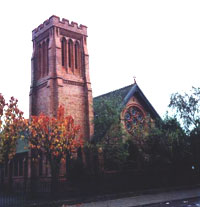The First 75 Years
Holy Souls' Church, Scunthorpe - The First 75 years 30th November 1911 - 30th November 1986 Transcribed from the booklet produced by James Dodd
When I was asked to write something of the early days of the parish of Holy Souls and its progress over the first 75 years, I began to regret that I had not taken more notice of what was going on in the parish during that period. Much of what is written about what has happened during most of that time is from my own personal recollection, and this at times may have been at fault. I was away from the parish for four war years, and was a member of St. Bernadette's from its inception in 1954 until 1968. I have been helped in filling the gaps from notes written by early anonymous chroniclers, and by talks with Mrs. Winifred Lynskey, Mrs. Mary Queenan, Mrs. Mollie Gilgallon, Mr. Tom Cunnane, Mr. Bill O'Donnell and Miss Mary Klauke, a daughter of Mr. Joseph Klauke, who built the church. Mr Bernard Grasar, brother of Bishop Grasar, provided notes about the work done in the early days by his father, William Matthew. My wife Elizabeth took notes for me and typed the manuscript. The cover illustration was done by Peter McNiven.
James Dodd.
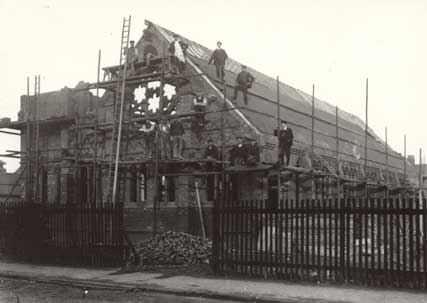 PRE - 1911 The census of 1851, the last before the
discovery of ironstone in the district, recorded that the area
which was to comprise the parish of Holy Souls has a total
population of 1,245. Iron ore was discovered (re-discovered really,
since there are many signs of early Roman and Saxon workings) in
1859, and the population at the next census, 1861 was found to have
increased by 178. During the first few years following discovery,
the quarried ironstone was sent to Elsecar, near Barnsley, for
smelting, and the number of workers required would not be large. In
1864 however, the first blast furnaces, Trent Ironworks, Dawes
Lane, went into operation, and at the next census, 1871, the
population was found to have been almost doubled, to 2,422. Twenty
years later, in 1891, the population , at 7,554, was more than six
times that at the middle of the century, and the nearest Catholic
church was at Brigg, eight miles away, the parish priest there
being a Fr. Kirby.
PRE - 1911 The census of 1851, the last before the
discovery of ironstone in the district, recorded that the area
which was to comprise the parish of Holy Souls has a total
population of 1,245. Iron ore was discovered (re-discovered really,
since there are many signs of early Roman and Saxon workings) in
1859, and the population at the next census, 1861 was found to have
increased by 178. During the first few years following discovery,
the quarried ironstone was sent to Elsecar, near Barnsley, for
smelting, and the number of workers required would not be large. In
1864 however, the first blast furnaces, Trent Ironworks, Dawes
Lane, went into operation, and at the next census, 1871, the
population was found to have been almost doubled, to 2,422. Twenty
years later, in 1891, the population , at 7,554, was more than six
times that at the middle of the century, and the nearest Catholic
church was at Brigg, eight miles away, the parish priest there
being a Fr. Kirby.
In the latter half of the 18th century, the worst excesses of the penal laws forbidding the practice of the Catholic faith were discontinued, and from about 1770 mass was said more or less openly in a house in Bigby Street, Brigg. In 1815, a French priest, Fr. Pierre Moulin, came to brig, and a Mr. Musgrave gave land and built a house for him. He was joined by his brother, Fr. Jacques Moulin, and these two priests built, it is said with their own hands, a chapel which served the Catholics of Brigg until 1873, when a building adjoining the Manor House, home of the Elwes family, was given to the parish and converted into the Church of St. Mary. The few Catholics in the Scunthorpe area were evidently making the journey to Brigg as frequently as they were able, to attend mass, and were taking their children there to be baptised. They would be known to Fr. Kirby and he would be aware of the need for a mission in Scunthorpe. By arrangement with a Mr. Field, Fr. Kirby came to Scunthorpe on the Feast of All Souls, 2 November 1892, and said mass in a house in Mary Street, the first public mass to be said in the area since the Reformation.
During the next five years, mass was said, with what regularity is not known, by Fr. Kirby and possibly by priests from other parishes arranged by him, and in 1897, Fr. Rupert McAuley was appointed priest in charge of the mission, to face a daunting task. With no church, no presbytery, in poor health and his nearest clerical neighbour eight miles away, it is not to be wondered at that he stayed only for seven months, before ill health obliged him to resign. There was no immediate successor, and the former role of Fr. Kirby was taken over by the Norbertine clergy, of Crowle, the Barnetby-Stainforth section of the Great Central Railway by this time having passenger services connecting Crowle with Scunthorpe. A Fr. P. Martens visited the parish as required until October 1898, when Fr. Joseph Hooker was appointed. Fr. Hooker had lodgings with Mr. And Mrs. Chamberlain, possibly at the Lord Roberts Hotel, before acquiring a house, the front room of which he furnished as the "Chapel of the Holy Souls," the house coming to be known as The Presbytery, and in effect establishing the parish of Holy Souls, Scunthorpe. None of the early records of the parish give any idea of the numbers of people who attended mass; to be accommodated in the front room of even the largest house in Scunthorpe suggests that the numbers were small. At the opening of the permanent church many years later it was reported that only a fair congregation was present. Another pointer is that Fr. Hooker made at least one drive for souls. On Sunday 18 December 1898, he hired the Assembly Rooms in Manley Street and held a mini-mission. A Mgr. Sabela preached at mass in the morning, and in the evening, in the presence of the Bishop of Nottingham, Dr. Bagshawe, when "Benediction was given with full panoply of candles, incense and flowers, to rejoice the hearts of all who love the romantic aesthetic ritual of devotion." There is no reference to the numbers attending.
 Fr. Mouthuy was a Belgian; how he came to be
in this country and available to the Bishop of Nottingham is not
known. There can be no doubt however, that he was hard-working,
astute, far-seeing and opportunist. He could not have been in the
town for more than a few months before he bought a piece of land on
Frodingham Road, with an option on the adjoining piece going on to
the junction of Frodingham Road and Berkeley Street. He built a
wood and corrugated iron structure, and furnished it as a church,
with a small sanctuary, an altar, bench seating and a pulpit. One
wonders where he got the money, although early photographs show
name places on some of the seating, which suggests that some form
of seat rent contributed to the cost. Some of the furnishing was
probably donated; it is said that the pulpit was purchased from
Frodingham church, but it may well have been a gift. There is nor
record of the date from which the church was first used, but again
it could not have been very long before Fr. Mouthuy learned of a
trust set up by a member of the Young family, of Kingerby Hall,
near Market Rasen, applied for a grant and got it, and actually
began the building of the permanent church before he left the
mission in 1910 to return to his native Belgium. No more is known
of why he returned than is known of how he came to be here in the
first place, but it can be supposed that it was an urgent summons
that took him from something that must have meant so very much to
him.
Fr. Mouthuy was a Belgian; how he came to be
in this country and available to the Bishop of Nottingham is not
known. There can be no doubt however, that he was hard-working,
astute, far-seeing and opportunist. He could not have been in the
town for more than a few months before he bought a piece of land on
Frodingham Road, with an option on the adjoining piece going on to
the junction of Frodingham Road and Berkeley Street. He built a
wood and corrugated iron structure, and furnished it as a church,
with a small sanctuary, an altar, bench seating and a pulpit. One
wonders where he got the money, although early photographs show
name places on some of the seating, which suggests that some form
of seat rent contributed to the cost. Some of the furnishing was
probably donated; it is said that the pulpit was purchased from
Frodingham church, but it may well have been a gift. There is nor
record of the date from which the church was first used, but again
it could not have been very long before Fr. Mouthuy learned of a
trust set up by a member of the Young family, of Kingerby Hall,
near Market Rasen, applied for a grant and got it, and actually
began the building of the permanent church before he left the
mission in 1910 to return to his native Belgium. No more is known
of why he returned than is known of how he came to be here in the
first place, but it can be supposed that it was an urgent summons
that took him from something that must have meant so very much to
him.
The choice of site is interesting. The area referred to at the beginning of this account comprised five separate villages set out in a north/south line from Crosby through Scunthorpe, Frodingham, Brumby, to Ashby, a distance of about 2 ¼ miles. At first, the village of Ashby was rather bigger than any of the other four, and remained so until the iron industry was established on the eastern side of the line of villages. After this, the population of Scunthorpe only was to increase significantly; Ashby was too far south of the early ironworks to be included in the rapid growth of population; Brumby had much better agricultural land than its neighbours, and large wooded areas. It remained much the same until rather later in the town's development, but remained exclusively residential. Crosby was bounded on the north and east by ironstone workings, and its population remained static for many more years. Both Scunthorpe and Frodingham were equally close to the scene of industrial development, and might have grown to equal importance but for the railway which, in 1864, was laid between Barnetby and Keadby, and which split the village of Frodingham in two from end to end, effectually preventing its development for all time. The industry continued to grow, the population to increase, and growth and increase were concentrated in Scunthorpe, which pushed its southern boundary up to the railway and its northern boundary up to Crosby. The site bought by Fr. Mouthuy for his church was virtually on the boundary between Scunthorpe and Crosby, and as near to the bulk of the population at that time as it could be.
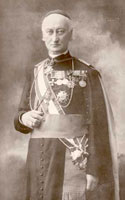
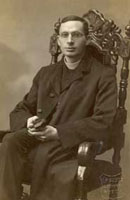 Fr. Mouthuy was
succeeded by Fr. Fred Askew (pictured right), a spare, ascetic
looking man, ordained only two years before and, it is said, a
qualified architect. He completed the church the following year
(the builder was a local man, Mr. J. Klauke), and it was opened and
consecrated on 30th November 1911 by the Bishop of Nottingham, the
Rt. Rev. Dr. Brindle, D.S.O (pictured left).
Fr. Mouthuy was
succeeded by Fr. Fred Askew (pictured right), a spare, ascetic
looking man, ordained only two years before and, it is said, a
qualified architect. He completed the church the following year
(the builder was a local man, Mr. J. Klauke), and it was opened and
consecrated on 30th November 1911 by the Bishop of Nottingham, the
Rt. Rev. Dr. Brindle, D.S.O (pictured left).
1911 - 1936 The church as it is today is not basically different from what it was at the time of its opening. Abutting on to the north side, at the east end, was a functional building known as the Conference Room, used for meetings, concerts, as a club room, for a little while as a small private school rejoicing in the name of St. Paul's College, run by a Mr. and Mrs. McNamee. Access to it, from the church, and to the sacristy which occupied a corner of it, was through one of two Gothic arches which, though long bricked up, still remain a feature of the northern side of the church interior. The western arch of theses two was to have been the entrance to a Lady Chapel which in the event was never built, and early photographs show the space across this arch to be occupied by the organ. The confessional was a box-like object near the entrance to the church.
Why the chapel was not built is not known; the plans included those for a presbytery and sacristy on the south side, and these were provided later. A chapel on the opposite side, intended to accommodate fifty people, was evidently meant to complement the handsome residence put up later. The altar and pulpit were taken from the temporary church, the altar being replaced in 1923, the replacement in turn being replaced in 1958, when the sanctuary was also enlarged and new altar rails installed. Fr. Askew left the parish in 1919. Never in robust health, the responsibility of a newly established parish, taken on so soon after ordination, was added to by his care and concern for the influx of Belgian refugees in 1914.
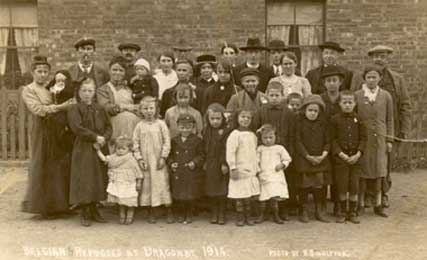 Mainly Catholic, these people had to
be accommodated both spiritually and in bodily comfort, and he took
it upon himself to provide a small church at Dragonby, where the
refugees were lodged. He probably designed it himself, paid for it,
and helped to build it, too, the building being wholly by voluntary
labour. The strain of wartime conditions, the problems arising from
the Belgian-speaking refugees, the physical effort of visiting
Dragonby, usually by bicycle, and the effect of the rapidly growing
population, combined to bring him near to breakdown, and he left
the parish to take up residence at Harborne Hall, a retreat house
near Birmingham, as chaplain.
Mainly Catholic, these people had to
be accommodated both spiritually and in bodily comfort, and he took
it upon himself to provide a small church at Dragonby, where the
refugees were lodged. He probably designed it himself, paid for it,
and helped to build it, too, the building being wholly by voluntary
labour. The strain of wartime conditions, the problems arising from
the Belgian-speaking refugees, the physical effort of visiting
Dragonby, usually by bicycle, and the effect of the rapidly growing
population, combined to bring him near to breakdown, and he left
the parish to take up residence at Harborne Hall, a retreat house
near Birmingham, as chaplain.
Fr. Askew appeared to have had an interest in Dragonby and is thought to believe it would develop as the industry grew. Mr. Joseph Kaluke, the builder of the church, was wanting work when the building was completed, and built a small terrace of houses at Dragonby, perhaps at Fr. Askew's suggestion. The terrace was called Rosary Cottages, and is still standing and occupied. Mrs. Josephine Klauke is still remembered as an organist, Sunday school teacher, and general helper in the parish.
Fr. Francis Firth, ordained in 1914, was appointed to succeed Fr. Askew, and one of his first tasks was to complete the building of the presbytery. He had come into lodgings in a house at the junction of Frodingham Road and Smith Street. In 1919, the five villages which formed the nucleus of the parish were amalgamated as the Urban District of Scunthorpe and Frodingham, with a population of about 25,000, and lodgings in a lay household could not be satisfactory for the care of what was now a large Catholic population.
Having completed the building of the presbytery, Fr. Firth installed a new altar, and replaced the Stations of the Cross brought from the old church with a new set, donated by parishioners, the name of each donor being inscribed on a small brass plate beneath the Station. Not a lot more is remembered of him. He was a genial man, with a fine singing voice, and he developed a very good choir under the leadership of Mr. Frank Gell, a noted local tenor. The second Mass on Sunday was almost invariably sung to a polyphonic setting, and Benediction always included the sung Litany of Our Lady.
The translation of Fr. Firth in 1925 to the country parish of Hassop with Bakewell is difficult to understand. In that year, work on the large and important extensions to the Frodingham Steelworks, projected during the war and shelved afterwards because of the depressed economic climate, was about to start, and it was evident that the town was going to develop. Particularly as the departure of Fr. Firth was to leave the parish without a replacement for the foreseeable future, it seemed odd to move an able-bodied young priest to a rural setting from an urban and expanding one. The next parish priest was not appointed until sixteen months later, and in the interval the parish was served by regular clergy from a small monastic house and school in the village of Panton, near Wragby, Lincolnshire. These monks were Capuchin Fathers of the Order of St. Francis, and two of them, usually their Superior, Fr. George, and Fr. Pacificus, would come to Scunthorpe on a Saturday, and leave on Monday morning.
Within a few months of their first coming they organised a Mission, the first of such that most parishioners had witnessed. It was an enjoyable and exhilarating experience. The church was filled every evening for a fortnight, when the Gospel and the doctrine were preached with missionary zeal. Mrs. Winifred Lynskey recalls a short mission being held some ten years before, when the missioner, faced with many empty seats, was constrained to say that it really was like preaching in the wilderness. There was nothing of the wilderness about Fr. George's mission; his service to Scunthorpe was appreciated by Catholics and non-Catholics alike; on more than one occasion he addressed a public meeting in the town.
Towards the end of 1926, Fr. Lambert Van der Kallen, of the St. Joseph's Foreign Missionary Society, was appointed to the parish from Corby, Northants. A devout man, he is remembered mainly for his spiritual innovations, one in particular being the Holy Hour, as an alternative once a month to the Rosary and Sermon before Benediction. Not a well man, he suffered a brief illness early in 1928, and died on 28 February of that year. His funeral, the first of a Catholic priest in Scunthorpe, was an impressive occasion, the Holy Rosary being recited in procession following the hearse, from the church to Crosby Cemetery.
Fr. Oswald Key, also of the St. Joseph's Missionary Society, had been sent to look after the parish during Fr. Van der Kallen's illness, and stayed on after his death. A hard worker, he inspired others to work willingly for him. He formed two committees, one of women and one of men. The women's committee provided a steady income from whist drives, sales of work, bazaars, etc.; the men's committee made themselves responsible for the physical maintenance and upkeep of the church. A believer in sodalities and confraternities, he founded the Children of Mary, the Guild of the Blessed Sacrament, and initiated the first moves in the formation of a Council of the Knights of Saint Columba.
Although it was always known that Fr. Key was on loan to Scunthorpe from Mill Hill, it was with dismay that the parish learned, after about a year, that a new appointment was to be made. A petition was organised to retain Fr. Key; whether or not it was ever presented to the Bishop is not known, but if it was, it was of no avail, and in August 1929, Fr. Albert Lakin arrived from Grimsby, and stayed for twenty years.
This period saw the town, and the country, climb out of the depression, prepare for and wage a war, and face the changes in the post-war world. All the local steelworks expanded, the population increased from 30,000 to more than 50,000, and housing developed extensively to the south and west. During the expansion of the steelworks, mass centres were established at some of the works to serve the transient labour force of such contractors as Sir Alfred McAlpine. However, the period covered in this section, up to 1936, did not see very much of this development, which really took off in 1937, and will be dealt with in a later section.
The first few years of Fr. Lakin's ministry saw the nadir of the economic depression, and a little in the way of innovation or development took place. The organ was replaced, a new pulpit was installed, and ornamental gates for the baptistery were provided. In 1936, the year of the Silver Jubilee, the church was completely, and some thought extravagantly, re-decorated. The central window at the back of the sanctuary was already a stained glass representation of Christ the King, installed following a bequest from Mr. John Hanly shortly after the initiation of the feast in 1925. Christ enthroned occupies the large quatrefoil light, the smaller trefoil and quatrefoil lights carrying representations of Our Lord's baptism by St. John the Baptist, and the archangels Gabriel and Raphael. Additional windows, on either side, representing Our Lady of Lourdes, with St. Bernadette Soubirous, and St. Therèse of Lisieux, and Saints Thomas More and John Fisher, canonised the previous year, were installed. Fr. Lakin commissioned four of the sanctuary windows to commemorate his parents, and of the remainder, one was given in memory of Thomas and Mary Stanford, one to mark Fr. Lakin's Silver Jubilee, one for Mary Ann Chamberlain, a leading member of the devoted band of people responsible for the establishment of the parish, and a triple window commissioned by the Grasar family. About this time, Fr. Lakin suggested that parishioners might like to replace the leaded glass in the side windows of the church with stained glass representations of saints or events as memorials. A number did so, but many of the original windows remained.
November 1936 marked the end of twenty-five years since the opening of the church; with a Catholic population of 1,050, it was the third largest in Lincolnshire, after Grimsby St. Mary's and St. Hugh's Lincoln, and only twelve parishes in the Diocese had populations significantly larger. The only recorded marking of the first twenty-five years is a reference in a local newspaper to the presence of the Bishop of Nottingham at the official celebrations on Sunday, the 21st of June, whatever they were. Whilst credit for the steady progressive development of the parish must go to the clergy, they would probably concede that people had played their part. It was the faith and devotion of people like Mrs. Chamberlain and the Field family which played a decisive part in getting the parish established, and Mr. William Matthew Grasar in the early years of the church's existence. Mr. Grasar came to Scunthorpe in 1910 from Ilkeston, Derbyshire, and set up a printing works behind his house, next to the church, and now Caritas House. He had taken over the magazine, The Dowry of Mary, in 1908, when its publisher, Canon McCarthy, died, and developed it until it had a worldwide circulation. Much of Mr. Grasar's spare time was devoted to the service of the church and its pastors. During the later years of this period unstinted help was given by Mr. William Queenan. One of the first things Fr. Lakin did was to disband the committees set up by Fr. Key. He did not care for committees, and looked around for a right-hand man. He quickly found one in Mr. Queenan, and there was little afterwards in the parish that this gentleman was not concerned with. He was awarded a papal honour, the Bene Merenti Medal for services to the Church, in 1955.

